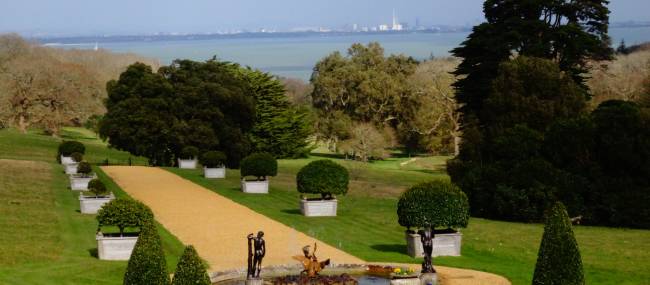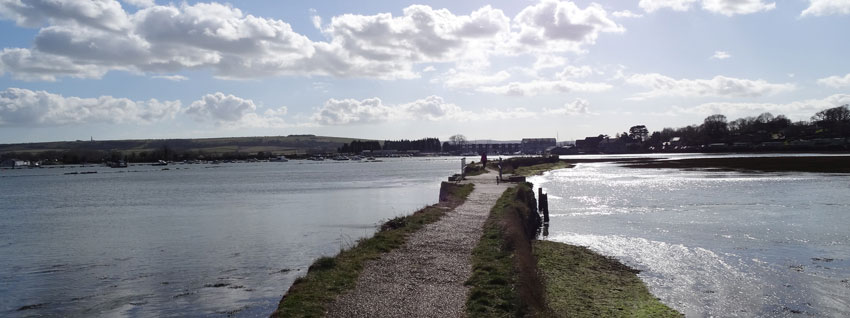
Manicured gardens of Osborne House
All about the Isle of Wight
Learn insider information about the Isle of Wight from our resident guide Jon Millen, who explains what makes this part of the British Isles so special. Find out more about our Isle of Wight walking and cycling holidays >>

The Isle of Wight is a great place for experienced and beginner walkers alike, with a generally mild climate, bracing hilly downs, sections of woodland and great sea views across 525 km of footpaths on an island of 381 square km. It is also home to the ‘Caulkers’: named after the people who used to proof the boards and hulls of the ubiquitous boats that plied between the island and the mainland or went fishing in its waters, it is used today to describe the indigenous people of the island whilst projecting the image of the separateness of the place. Despite being geographically close to the cities of Portsmouth, Southampton and even Greater London, it is still surprisingly detached. Although there is talk of building a new road bridge, economic benefits are debated and speculated, as a lot of the local people still want the isolation and the quasi-independence that the rising waters of the Channel and the flooding of the River Solent gave to the island 8,000 years or so ago.

WHAT IS SO SPECIAL ABOUT THE ISLE OF WIGHT?
I remember back in the 1970s and ’80s people were joking that resorts on the Isle of Wight were just like how the British seaside used to be in the 1950s. On my most recent visit in 2015, people were still comparing it to, well, British resorts in the 1950s – however that may be a little harsh! Although much of its modern tourism is based upon its original Victorian and Edwardian infrastructure and of course sailing, the Isle of Wight has pioneered outdoor, farm-based rock festivals since 1968, attracting upwards of 150,000 people – you will even find a
statue of Jimi Hendrix at Freshwater Bay!
Nowadays many of the seaside towns have modernised their image so you will find some great pubs and restaurants with very appealing fayre. Ventnor has reinvented itself as a health spa town and Cowes is fashionable for shopping as well as a yachter’s cornucopia. But other areas trade much more upon their historical past.
Freshwater Bay reflects its links with Alfred Lord Tennyson,
Blackgang Chine reminds us that it is the oldest theme park in Britain (dating from the 1840s!) and who can forget Queen Victoria’s beloved Italianate
Osborne House… Why go to the Italian Riviera when you can stand overlooking the Solent with a bag of fish and chips from the ‘Cod Father’ takeaway?
You may even stay in a pub which was built from the timbers of a ship wreck – dozens occurred around the island and was one of the sporadic ‘benefits’ of living here!

WHAT ABOUT WALKING IN PARTICULAR?
The island is perfect for leisure walking. The single most important thing to remember is that the island is conservative and the countryside is very well preserved, with more than half of the island designated as an
Area of Outstanding Natural Beauty. But much of the rest is similarly very attractive, even down to some of the old brick-built seafront villages, such as Seaview, or the beautiful micro-fishing village of Steephill Cove, which is hidden away in a coastal crenulation with some thatched cottages and a great fish restaurant.
There is also a lovely
Coastal Path, threading its way between the wonders of the island. Coastal erosion means that, for safety reasons, there are some diversions in place that take you inland around the areas of collapsing clay cliffs and boggy slumps.
FAVOURITE TIME TO WALK ON THE ISLE OF WIGHT
I would recommend April to late June, before the schools break up, and September and October. The spring and early summer often has low rainfall and beautiful spring flowers within the woodlands with bright emerald leaves on the trees, while the autumn period has a more rustic golden charm. Of course sea fogs can be notorious and can roll in at any time!
It is best to avoid the heaving summer ‘bucket and spade’ season and the August Cowes weeks – although the trails can be quiet, resorts and towns are very busy. There are several music, walking and cycling festivals taking place in May, so similarly that month can vary in terms of busyness.

HIGHLIGHTS OF A WALKING HOLIDAY ON THE ISLE OF WIGHT
Any given day along the Coastal Path will take you through some wonderful areas. Osborne House is quite a sight, especially the ‘Durbar Room’ and the beautiful paintings of some of Queen Victoria’s ‘Indian subjects’. You can walk down to her private beach for a peek of her original ‘swimming machine’, which has been recently restored or visit the nearby
Quarr Abbey, an astonishing brick-built abbey.
There is also an interesting
chain ferry that takes you from East to West Cowes across the River Medina. There has been great resistance to building a bridge, as tradition is very important.
Three hours walking from Cowes you arrive at a village called Newtown. Today this is merely a street of houses, an attractive church and a
town hall owned by the National Trust but it used to be the biggest town and busiest port on the island – that is until 1377, when the French sacked the place! However it is best known as a ‘Rotten Borough’: despite only a few families living here, until the 1832 Reform Act it could elect 2 MPs into the English parliament, the same as cities such as Birmingham.
Further on is
Yarmouth, a town with some mediaeval features and noted for a swashbuckling past. Privateering, or more commonly known as pirating, was very prevalent. One of the Governors of Yarmouth sailed out and captured a French ship carrying a marvellous marble statue of Louis XIV, which was to be presented in Paris to the Sun King. Instead, the Governor had its face knocked into his own image and installed it within the local church.
The trail winds past a fortress with a construction of a huge nuzzle loaded canon. These ‘Palmerston Forts’, named after the warmongering minister, are also dotted around the coast and point to a time as late as the 1850s and ’60s, when Britain still feared attack from France. There are great views over the Portland and the huge defensive complex, where once Charles I was held prisoner during the English Civil War.

The walk undulates over cliffs and downs to pass through
The Needles Park, where the chalk backbone of the island dives into the sea like a dragon’s tail with chalky sea-stack scales. If you decide to continue further downlands you will find Victorian memorials, a thatched church, as well as gun placements from World War ll.
The Isle of Wight is also home to the only surviving mediaeval lighthouse in Britain, which can be found at the St Catherine’s Oratory. The steep walk up is definitely worth it. Coming here at sunset is a beautiful experience as you can follow the coastline all the way back to The Needles!
FAVOURITE FOOD AND DRINK ON THE ISLE OF WIGHT
The Isle of Wight is known for its fresh seafood, which these days translates at crustaceans more than anything else! Any self-respecting pub or restaurant on the island will make the best of its seafood menu, with the Crab and Lobster Inn in Bembridge probably being the most famous of all. For more of an authentic marine experience, just before a causeway crosses Bembridge Harbour on the east of the Isle, there is the floating seafood The Best Dressed Crab restaurant at Fishermans Wharf, where you can taste fresh lobster or have a crab and prawn sandwich washed down with a zingy tasting beer. You can also try the seafront Boat House Restaurant in gorgeous Steephill Cove and there are of course great takeaways such as the aforementioned ‘Cod Father’ in Ryde.

OTHER RECOMMENDATIONS
Bring your binoculars with you, as you will need them for coastal observations and also looking at bird life. If you belong to the National Trust don’t forget your membership card for the Old Battery on The Needles and if you are a member of English Heritage use your card for entry to Osborne House and Yarmouth Castle. Take a boot brush with you – wet conditions are not uncommon on the island, often resulting in plenty of muddy clays. On the contrary, if you expect hot weather, pack your swimming costume, water shoes and maybe even bring a kite, in case you decide to spend the day on the beach!
MORE INFORMATION
For more information on visiting the Isle of Wight visit our Walking & Cycling Holidays on the Isle of Wight page.